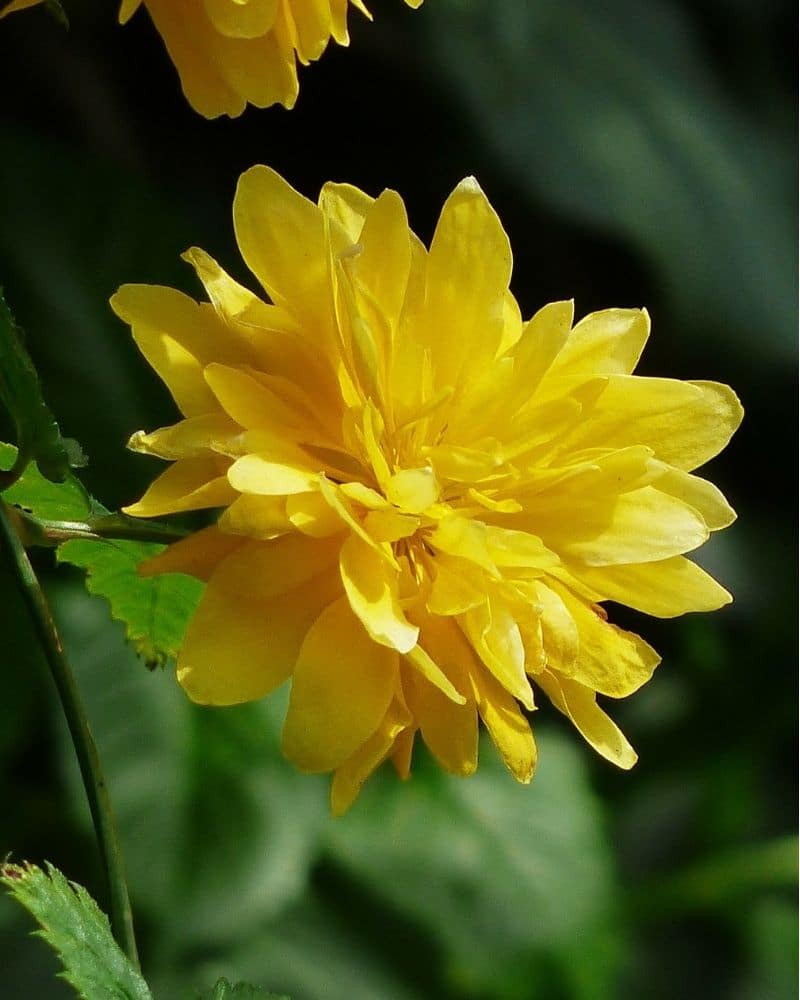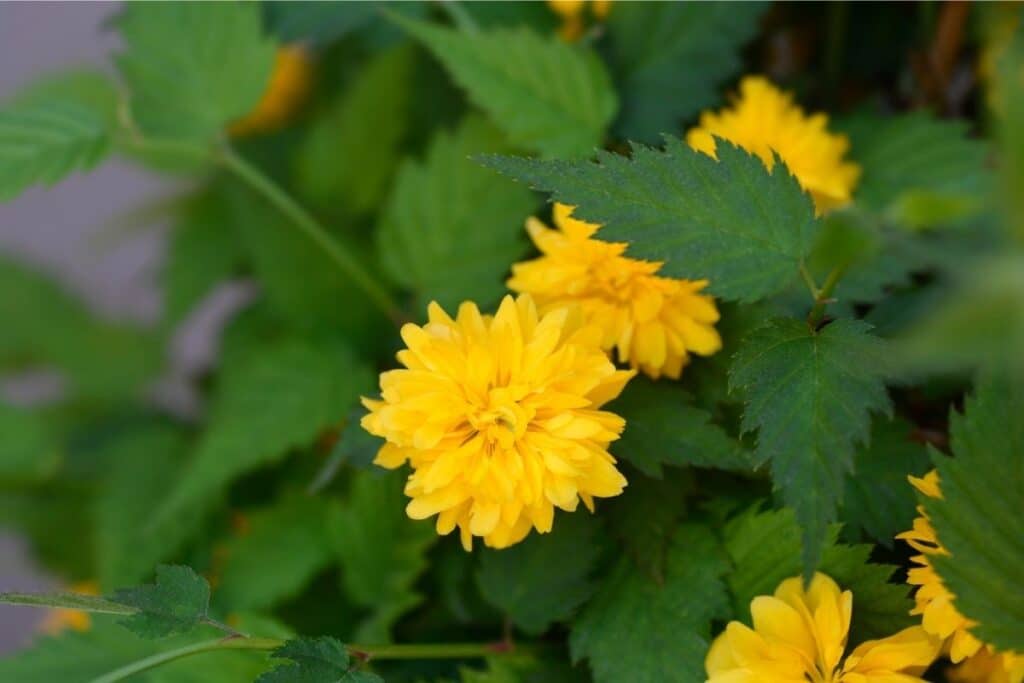The Japanese Kerria plant is a lovely shrub that blooms during late spring and sometimes during the early summer. This plant catches everybody’s attention as it displays double yellow flowers with bright green stems and foliage.
This showy plant will look great in any garden, especially when combined with other colorful plants.
Continue reading if you would like to know more about these flowering shrubs.
Basic Facts about Japanese Kerria
- This plant is often referred to as Kerria japonica, Japanese globeflower (1), Kerria japonica pleniflora, Japanese rose, Japanese marigold bush, or easter rose. They belong to the Rosaceae family of plants.
- They will thrive best in zones 4 to 9, according to the USA Department of Agriculture.
- This deciduous shrub produces plenty of gorgeous flowers that have vibrant yellow petals.
- As its name suggests, this plant is native to Japan and the mountainous regions of China (2), yet, it can now be found everywhere globally.
- This deciduous shrub has single or double flowers that appear profusely during the warmer months.
- It’s also great for shaded forest gardens and shrub borders, where it may sucker and spread.
- Plants that have been established are drought tolerant and deer resistant.

How To Grow and Care for Japanese Rose
Growing Japanese Kerria is not as difficult as it may seem. Here is everything you need to keep in mind when growing this beautiful shrub:
Light Requirements
This shrub thrives in a partial shade area. This way, they will produce more blooms throughout spring. In fact, the more shade they have, the more vibrant their petals’ will be.
If having a shaded area is not possible, this plant will do perfectly well receiving full sun. Remember that its flowers fade quickly as they won’t receive too much intense exposure.
Water Needs
Japanese Kerria is known for being a thirsty plant. This means that they will require plenty of regular watering to thrive. However, gardeners must be careful not to overwater the plant, as they could be potentially damaging its roots.
Water this plant every other day if the weather is warm. If the weather is cool, you can water it once or twice a week.
As a general rule, place a finger or two inside the soil. If it’s still too damp, then do not water the Japanese Kerria. On the other hand, if it’s almost or entirely dried, then it is advisable to water the shrub thoroughly.
Soil Preferences
This shrub is not fussy about the type of medium it grows on. As a result, the Japanese marigold bush could perform well enough in poor soils, albeit they will thrive best when the soil has plenty of organic material, such as decomposed leaves or compost.
Soil moisture is also an important factor to consider when growing Japanese marigold bushes. These plants prefer well drained soil that is kept consistently moist but does not cause root
Pests and Diseases
This plant is susceptible to both leaf blight and the kerria twig, a fungal disease that could damage the whole plant very rapidly.
If these problems appear, then reddish spots will appear throughout the foliage, affecting the leaves’ coloration, and then they will simply die off.
Gardeners can use organic fertilizer to prevent the plant from catching this disease, especially during wet summers known for increasing the risk of these fungi.
Pruning
Ideally, you would prune the Japanese rose as soon as it stops flowering during late spring or early summer. What’s more, it would be best to prune dead branches as soon as you see them. This will allow the plant to grow healthier and more rejuvenated.
If this plant is in a small area, and you don’t want it to spread out vigorously, then you must remove the suckers as soon as they appear. This way, you will be sure that the potential spread is under control.
Propagating Japanese Kerria
Propagation must occur at the beginning or mid-summer when all the flowers are entirely dead. You should choose a branch and cut the terminal end, just underneath the leaf node, where the foliage starts to appear.
The remaining leaves, which are still attached to the branch, should also be removed during this procedure.
Ideally, you should put rooting hormones on the branch you have cut, and only then will you be able to put it in an appropriate-sized pot with a mixture of sand, compost, perlite, and peat moss, if possible.
The cut should be misted regularly, and it should be located where it doesn’t receive direct sunlight. The plant’s roots should start developing within the following six weeks, although, depending on the weather, this period could take longer.
Once the roots start developing, you could transplant the Japanese kerria into a bigger-sized pot. If not, you could place it directly into the garden, if the weather permits.

Types of Japanese Kerria Bush
These are some of the Japanese roses’ varieties:
Plentiflora
One of the few double-flowered plants on this list can only reach up to 2 inches in width, yet they can grow up to 10 feet tall. They resemble pom-poms, and they are often seen in sidewalks, overtaking other types of plants.
This flower resembles another beautiful flower, the chrysanthemum.
Picta
This variety takes its time to grow, which is incredible, considering they will only grow up to 2 feet tall. Thus, this makes them one of the shortest varieties of Japanese roses.
Albescens
This type of kerria japonica is easy to identify as it has soft-creamy yellow flowers. They can reach up to 5 feet in height, and around 2 inches in width. Another interesting aspect is that its foliage will turn pale yellow as soon as fall arrives.
Golden Guinea
Another small flower, as the blooms will only reach 2 inches in width. This Japanese Kerria can grow up to 8 feet tall. These flowers have a lovely fragrance.
Simplex
This unique plant will rebloom year after year, making it an ideal shrub for lazy gardeners who still want to enjoy a pop of color in their garden.
FAQs
Is kerria invasive?
Kerria japonica is not typically considered invasive. It is a well-behaved shrub and is not known for aggressive spreading.
Why is my kerria dying?
Several factors could contribute to a kerria dying, including overwatering, underwatering, poor soil drainage, or disease. It’s essential to assess the growing conditions, address any issues, and ensure the plant receives proper care.
Will Japanese kerria grow in shade?
Yes, Japanese kerria (Kerria japonica) can thrive in partial to full shade. It is known for its adaptability to different light conditions, making it suitable for shaded areas in the garden.
How do you prune kerria?
Pruning kerria is generally done after the growing season. Remove dead or damaged wood, and thin out some older stems to encourage new growth. It’s a good idea to maintain a balanced and open structure to enhance air circulation.
How long does Japanese kerria bloom?
Japanese kerria typically blooms in early to mid-spring, with its bright yellow flowers lasting for several weeks. The exact duration can vary based on the specific cultivar and growing conditions. Regular pruning and proper care can contribute to more prolific blooming.
Conclusion
One of the most beautiful flowering plants in the world, the Japanese Kerria is not only easy to maintain, but it also provides an excellent view that welcomes gardeners to their land.
This plant has numerous yellow flowers that resemble roses, and they will bloom throughout the Spring, making any space look ten times better.
References
Reference List:
- https://aggie-horticulture.tamu.edu/syllabi/608/Lists/Fourth%20Edition/Kerriajaponica.pdf
- Huo Y, Yan M, Zhao X, Zhu Z, Yuan Z. The complete chloroplast genome sequence of Kerria japonica (L.) DC. ‘pleniflora’ (Rosaceae). Mitochondrial DNA B Resour. 2019 Oct 23;4(2):3723-3724. doi: 10.1080/23802359.2019.1678433. PMID: 33366160; PMCID: PMC7707439.
Close
*image by nahhan/depositphotos







